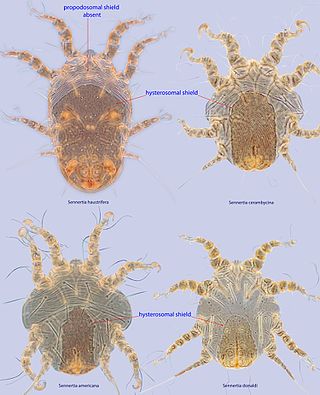
The Acaridae are a family of mites in order Sarcoptiformes.

Mesostigmata is an order of mites belonging to the Parasitiformes. They are by far the largest group of Parasitiformes, with over 8,000 species in 130 families. Mesostigmata includes parasitic as well as free-living and predatory forms. They can be recognized by the single pair of spiracles positioned laterally on the body.

Epidermoptidae is a family of acariform mites. They live as parasites on the skin of birds and mammals. They thrive in warm, damp areas of the skin.

Histiostomatidae is a family of mites in the clade Astigmata.
The Macronyssidae are a family of parasitic mites in the order Mesostigmata.
Prolistrophorus grassii is a parasitic mite in the genus Prolistrophorus. It was described as Listrophorus grassii in 1954 from the marsh rice rat in Georgia. In 1974, Fain and Hyland placed it in Prolistrophorus and in 1984, Fain and Lukoschus redescribed the species on the basis of collections from the marsh rice rat in Georgia, Alabama, and Florida and the southern bog lemming in Indiana, West Virginia, and Iowa.
Horstia is a genus of mites in the family Acaridae.

Thyreophagus is a genus of mites in the family Acaridae.
Rhinoseius is a genus of mites in the family Ascidae.
Otopheidomenidae is a family of mites in the order Mesostigmata.

Ptilonyssus is a genus of mites in the family Rhinonyssidae. There are at least 230 described species in Ptilonyssus.

Halarachnidae is a small family of mites in the order Mesostigmata.
Chaetodactylus is a genus of parasitic mite primarily associated with solitary bees with over 20 species.

Winterschmidtiidae is a family of mites in the order Astigmata.

Sennertia is a genus of mites in the Chaetodactylidae family. There are more than 70 species. Some of these mites are parasites or commensals of bees, but the presence in some bees of specialized structures for carrying mites (acarinarium) indicates the mutualistic nature of the relationship of some species. Most species of the genus Sennertia settle on adult bees as heteromorphic deutonymphs, but the species Sennertia vaga has no deutonymph and settle on adult bees in the eating adult stages. Reproduction and feeding occurs during resettlement. Most species occur on small carpenter bees (Ceratina) and large carpenter bees (Xylocopa) of the family Apidae. A few species are associated with Centris (Paracentris) in the Neotropics.
Fritz S. Lukoschus (1919–1987) was a German zoologist studying the systematics and biology of the Acari. Over the course of his career he published over 200 scientific articles, describing more than 90 species new for science. Lukoschus was born in April 1919 in Grabsten in April 1919. He obtained his PhD in 1946 from the University of Göttingen on a thesis on the development of castes in the European honey bee. After working at the University of Göttingen until 1953, he worked at several institutions before being recruited by the Catholic University of Nijmegen in 1962 where he stayed until his retirement in 1984. Lukoschus died suddenly in August 1987. The genera Lukoschus and Lukoschuscoptes were named after him.
Hypoderidae is a family of mites belonging to the order Astigmata.
Radfordia is a genus of mites belonging to the family Myobiidae.
Suidasiidae is a family of mites belonging to the order Sarcoptiformes.
Laminosioptidae is a family of mites belonging to the order Sarcoptiformes.









